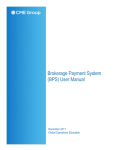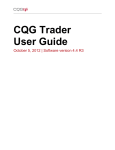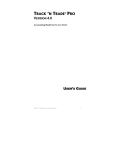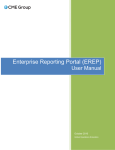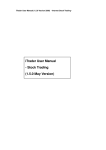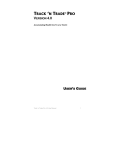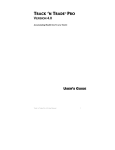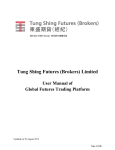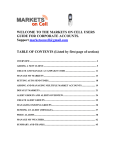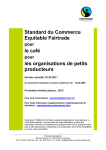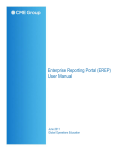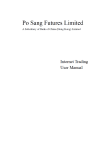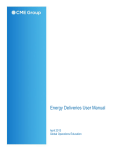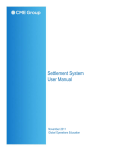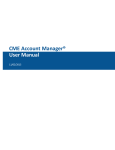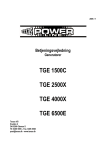Download Vantage - System Manual
Transcript
System Manual Table Of Contents Overview .............................................................................................................. 1 Account Inquiry .................................................................................................... 2 Account Watch List .............................................................................................. 3 Active Account Drop-Down .................................................................................. 4 Automated End of Day Procedures...................................................................... 5 Changing Your Password .................................................................................... 6 Chatting................................................................................................................ 7 Chatting - Overview .......................................................................................... 7 Chatting - Chat User List & Chat Window......................................................... 8 Contract Selection.............................................................................................. 10 Event Log ........................................................................................................... 11 Event Log - Overview ..................................................................................... 11 Event Log - Preferences ................................................................................. 12 General Preferences .......................................................................................... 14 Help Menu.......................................................................................................... 16 Month Codes .................................................................................................. 16 Update Default Layouts .................................................................................. 17 Upload Log Files............................................................................................. 18 Check For Updates......................................................................................... 19 Support Info .................................................................................................... 20 Layouts............................................................................................................... 21 Layouts - Overview......................................................................................... 21 Layouts - Saving a Layout .............................................................................. 23 Layouts - Opening a Layout............................................................................ 24 Layouts - Floating a Window .......................................................................... 26 Layouts - Preferences..................................................................................... 27 Links................................................................................................................... 29 Market Book ....................................................................................................... 31 Market Book - Overview ................................................................................. 31 Market Book - Adding a Contract.................................................................... 33 Market Book - Placing an Order ..................................................................... 34 Market Book - Drag and Drop Cancel/Replace............................................... 35 Market Book - Preferences ............................................................................. 36 Notifications........................................................................................................ 38 Order Entry......................................................................................................... 41 Order Entry - Overview ................................................................................... 41 Order Entry - Entry Fields ............................................................................... 42 Order Entry - The Quote Grid ......................................................................... 44 Order Entry - Saving an Order Template ........................................................ 45 Order Entry - Processing Choices .................................................................. 46 Order Entry - Preferences............................................................................... 47 Order Watch List ................................................................................................ 50 Print Settings...................................................................................................... 52 Quick Order Entry .............................................................................................. 54 ii Table Of Contents Quick Order Entry - Overview......................................................................... 54 Quick Order Entry - Preferences .................................................................... 55 Quote Page ........................................................................................................ 57 Quote Page - Overview .................................................................................. 57 Quote Page - Adding a Contract..................................................................... 58 Quote Page - Placing an Order ...................................................................... 59 Quote Page - Other Functions........................................................................ 60 Quote Page - Preferences .............................................................................. 61 Quote Page - Tab Management ..................................................................... 63 Quote Page - Moving and Removing Contracts ............................................. 64 Quote Provider ................................................................................................... 66 Reports............................................................................................................... 67 Research............................................................................................................ 68 Review & Release.............................................................................................. 70 Server Connection Status .................................................................................. 73 Spread Order Entry ............................................................................................ 74 Sounds ............................................................................................................... 75 Status Types ...................................................................................................... 76 Upgrade Notice .................................................................................................. 77 Virtual Desktops ................................................................................................. 78 Virtual Desktops - Overview ........................................................................... 78 Virtual Desktops - Menu Entries ..................................................................... 79 Virtual Desktops - Preview Pane .................................................................... 81 Virtual Desktops - Other Features .................................................................. 83 Web Admin......................................................................................................... 84 Window Menu .................................................................................................... 85 iii Overview This application is an order entry system intended for use by all types of market participants. It will provide users with the ability to place futures and options orders, have access to market depth & real-time quote information, and perform data analysis with charting. Furthermore, it also provides comprehensive views of all activity at an individual or consolidated level to ensure that a user always has a clear view of what trades have taken place. The application gives users the opportunity to view all accounts they have access to or just monitor certain ones. Built-in chatting functionality will allow users to keep in touch with each other on important developments. Most of all, a user has myriad ways to customize and reshape the application to fit their own style and preference. 1 Account Inquiry This screen is a link to web-based positions and trades information for a selected account. It can be reached via the Account Inquiry button on the toolbar . Keep in mind that in order for this toolbar button to be active, you must have an account specified in your Active Account Drop-Down. This screen can also be reached via the Order Entry or Spread Order Entry windows via the found to the right of the Account Name field. button 2 Account Watch List The Account Watch List shows a user the list of all offices, sales codes, accounts, and sub-accounts that they have security rights to interact with. These permissions can be changed via Web Admin. This mechanism is used to determine what accounts show up in a user's Active Account Drop-Down as well as to specify what account's transactions the user would like to see on their Top Day Order Manager. The example below shows 1 office with multiple sales codes, each of which have multiple accounts. An office is the highest level of aggregation for accounts and represents an organization collectively. An office is then broken down into 1 or more sales codes. Sales codes can be used to group accounts represented by different personnel at the organization or to differentiate accounts used for different types of trading. All offices will have at least 1 sales code, as this is a required construct in the account model. Below a sales code any number of accounts can exist. Finally, in some cases, one or more sub-accounts can exist for an account. Things to keep in mind about the Account Watch List: • A user can select/de-select all entries in the Account Watch List via the checkbox at the bottom left of the screen • If a user only has access to some portions of a level (ie.. some accounts under a sales code), they cannot select that entire level for their watch list (ie.. the entire sales code). 3 Active Account Drop-Down The Active Account Drop-Down is populated with the accounts a user specifies in the Account Watch List screen. Selecting an account out of the drop-down will populate the corresponding account field in the Order Entry Window: The same is true for the Spread Order Entry & Market Book windows. Additionally, if a user performs any type of quick order entry operation, the account specified in the Active Account Drop-Down will be the account used on that order. Here's an Example: 4 Automated End of Day Procedures At the end of each trading day, the system's back-end infrastructure handles the following activities: • Expire appropriate working orders • Move all expired orders to history • Reset broker-set account limits (day & order) This process will run nightly at approximately 7pm CST. This process will be altered when end of session expiring is implemented. In this model, if the trading session for a product ends at 1:30pm, the orders against the product would expire very shortly after this. Please understand that no end of day processing will happen on your local machine. As a result, you do not need to stay logged in overnight or during the time frame that end of day will run in. In fact, it is recommended that you log out each night when you are done using the application. 5 Changing Your Password Function to allow the changing of a user’s password. The change password function can be accessed from the Tools menu: Keep in mind, you must know your old password in order to create a new one. If you can't remember your old password, contact your administrator to have them change it for you. 6 Chatting Chatting - Overview The application provides the ability for users to chat with a pre-defined set of users they have access to. The list of users a user can chat with can be set in Web Admin by an authorized administrator. Here is an example of a chat session between 2 users: Computer 1 Computer 2 When a user receives a chat, an indicator will flash on the right-side toolbar and a sound will play. Here is an example: 7 Chatting - Chat User List & Chat Window The Chat User List can be reached via the toolbar button Chat User List from the Tools menu. 8 or by selecting Event Log The Chat User List window displays all users a user has permission to chat with, and specifies who is online or offline. In order to initiate a chat session, a user can double click on the name of the user they wish to chat with or they can right click on that user's name and select 'open chat screen'. Also, a user can right click on a user and select 'view contact details' to see the user's name and the group they belong to. 9 Contract Selection Throughout the application, a uniform interface component for future/option contract information input has been placed. With this tool a user can directly input the information for the desired contract or locate it through a tree view screen, sorted by exchange, symbol type, or category. NOTE: If you prefer to see Mo/Yr displayed prior to Symbol, this can be changed via the Preferences screen, General section. The Select a Contract screen is reachable via the drop-down and works like this: button to the left of the P/C 10 Event Log Event Log - Overview The Event Log window is meant to act as a recorder of all actions a user has taken during their current session (since they last logged in). The grid contains the time, account (for orders), action, status, message, and server order number (for orders) for all operations that have taken place. In addition to orders placed and their continued statuses, the Event Log will also show when the user logged in and when downloads for the Top Day Order Manager took place. All columns on the screen can be relocated and resized. Filtering can be done on all columns individually. All columns on the grid can be relocated, removed, and resized. Each column can be sorted by clicking on the column header. Filtering is also available for all columns by clicking on the button and selecting the specific value or setting preferred. For examples of grid manipulation, go here. 11 Event Log - Preferences The Preferences screen can be reached via the the Tools menu: 12 button on the toolbar or from Help Menu The Preferences screen contains the following parameters configurable specifically for the Event Log window: • Display Appearance • Number of Messages: How many records should be displayed in the event log grid. • Use Colors: Should the screen use the colors defined for the Top Day Order Manager screen to denote different types of orders. 13 General Preferences The Preferences screen can be reached via the the Tools menu: button on the toolbar or from The application contains a few preferences that affect the overall functionality of the application. These are as follows: 14 Layouts • Display Symbol Before Mo/Yr: The Order Entry, Spread Order Entry, Market Book, Chart and Option Strike Matrix screens all utilize a component containing the attributes for specifying the contract to be added/viewed on the screen. By default, the display order is symbol and then Mo/Yr. This can be altered via this preference. vs. • Display Exit Warning: The application can be set to ask you if you meant to exit it. You have the choice to leave or cancel the exit command. • Display Queue Popup: This preference determines if the user would like to see the Queued button on the Notification toolbar and the Queued tab on the Notification window. Queued orders are those placed during 'off' hours for a given contract, which will be auto-submitted when the market opens. 15 Help Menu Month Codes A user can view a listing of the month codes used when specifying month/year combinations on contracts via the Help menu using the Month Codes link. 16 Update Default Layouts As discussed in the Layouts section, users can choose to use the application with one of the supplied default layouts. As new enhancements are made to the system these layouts can become obsolete. As a result, it is possible to manually download the new layouts via the 'Update Default Layouts' choice under the help menu: Upon clicking the selection on the menu, you would see this screen: Upon completion of the update, you'd see this dialog: 17 Upload Log Files In the event you experience problems with the application, support personnel may ask you to upload your log files. This can be done from the help menu by selecting Upload Log Files: Upon clicking the selection on the menu, you would see this screen: Upon completion of the upload, you'd see this dialog: 18 Check For Updates From time to time, updates to the application will be released. You should be notified of these automatically, but for any reason if you are not and/or would like to check for updates, you can do so from the help menu by selecting Check for Updates: Upon clicking the selection on the menu, you would see this screen: Upon clicking Yes, if you're using the latest version of the application, you'd see this dialog: Otherwise, it would notify you that a newer version is available and prompt you to install it. 19 Support Info The Support Info screen can be reached via the Help menu using the Support link. This screen is customizable per office instance of the application. The text of this window can be customized via Web Admin. 20 Layouts Layouts - Overview The application’s windows can be resized and arranged in many ways. A user can create a layout which will save columns to display & sizing for grids, window sizes, and positioning. Keep in mind when resizing windows that some have a minimum size to facilitate always showing the elements of the screen. Finally, don't forget that windows can also be ‘floated’ outside of the application window itself, allowing for many different possibilities in a multiple monitor configuration. A user can create many different layouts to assist them in different types of trading activity. Example of a Layout: 21 Example of a Layout utilizing multiple monitors: 1st Monitor 22 2nd Monitor Market Book Layouts - Saving a Layout Once a user configures the application windows the way they want it for a layout, they can save that layout by clicking the Save button on the toolbar selecting Save or Save As… from the File menu. or by The following window will be displayed if the layout is new: The layout will be saved to the directory displayed in the Preferences for Layouts with the specified name. You can also choose one of the existing layouts to be replaced by the new one. 23 Layouts - Opening a Layout A layout can be opened by clicking the Open Layout button on the toolbar by selecting Open Layout from the File menu. or The following window will be displayed to choose the layout to open (the choices in the window are taken from the folder specified in the Preferences for Layouts): In addition to the layouts that a user has saved, the application's default layouts can also be easily reached from the Open Default Layout... entry under the file menu: 24 Market Book Here is the list of default layouts: The Retail - Order Entry layout is the default layout that will come up in the application the first time it is opened. When a user closes the application for the first time, they will be required to save a new layout, since the default layouts cannot be changed. 25 Layouts - Floating a Window When configuring windows for a layout in the application, a user may wish to take advantage of multiple monitors connected to their system. Application windows may be set to 'float' outside the application window (and thus made available for dragging to another monitor) in the following way: If when changing a layout, you decide that you no longer want to 'float' a window outside the application, you can simply repeat the process to float it (click at the top left of the window in question and select Float Window) and it will re-appear back inside the application. 26 Market Book Layouts - Preferences The Preferences screen can be reached via the the Tools menu: button on the toolbar or from 27 The Preferences screen contains the following configurable parameters: • 28 Defaults • Folder: The folder the user would like their layouts saved in. The length parameter nested under the Folder option is for display purposes only. NOTE: Keep in mind that you must have write permissions for the folder you specify here. • WARNING: By default, many configuration files, layouts, sounds and log files are saved to the My Documents folder in an appropriately named folder. Do not delete this folder or any of its contents as it will damage your installation of the application. • Save On Exit: True/False value to determine if the user would like the current layout displayed in the application to be saved upon exit from the application. Links The Links window can be reached via the toolbar button from the Tools menu. or by selecting Links This window provides the user with links to various industry-related websites. An authorized administrator can remove or add new links via Web Admin. 29 Here is the Links page with the default Links shown: 30 Market Book Market Book - Overview The Market Book window is used to view the activity of the selected active account (and all watched accounts, if desired) for a particular contract at various prices. From this view, users can view order contract quantities placed for the active account and/or all accounts that the user has defined in their account watch list. 31 The button to the right of the grid will always take the user back to the center of the market. The up and down arrows navigate the prices available for that contract, with the / moving the grid up/down one price and the / shifting the grid by an entire page of prices. The watched orders and <account> orders columns can be hidden on the grid. Right clicking in any unpopulated portion of the screen gives the user the option of cloning the Market Book or setting it to Stay On Top. 32 Order Entry Market Book - Adding a Contract A contract can be added to the Market Book by entering the contract information and clicking the Go button or by clicking on the Select a Contract button and then navigating to the desired contract, selecting a particular expiration, clicking the Select button, and then clicking the Go button. NOTE: If you prefer to see Mo/Yr displayed prior to Symbol, this can be changed via the Preferences screen, General section. 33 Market Book - Placing an Order Once a contract has been added to the Market Book, orders can be placed against it. This can be done in one of three ways depending on what type of trade the user would like to make. If a limit order is desired, the user can simply left click on the colored cell for Bid Qty or Ask Qty at the desired price. If a user were to right click in the same location for a given price, they would see choices of create stop at <price> (only appears for prices below market for Ask Qty and for prices above market for Bid Qty), create limit order, and create market order. If the user would like to buy or sell at the market or bid/ask, this can also be done via the buttons at the bottom of the window. Additionally, the user can request to cancel all buys or sells. 34 Order Entry Market Book - Drag and Drop Cancel/Replace A user may drag an order quantity from one price to another by left clicking on the quantity and dragging the mouse to the desired price: 35 Market Book - Preferences The Preferences screen can be reached via the the Tools menu: 36 button on the toolbar or from Order Entry The Preferences screen contains the following parameters configurable specifically for the Market Book page: • • • • Display Options • Hide Watched Lots Columns: True/False value indicating if the watched lots columns should be hidden or not. Grid Centering • Automatic Centering: True/False value to denote if the grid should automatically be centered on activity on the contract. • Refresh Interval: Numeric value for how often the centering refresh should occur. • Refresh Scale: Qualifies if the refresh Interval is in minutes or seconds Notifications • Confirm Order Submission: Determines if the user would like to be shown a simple or detailed order ticket after placing an order or if they would like no ticket at all. Trading Defaults • Order Duration: Sets the default order type as 'Day' or 'GTC' (good until cancelled). • Quantity: Sets the default quantity for orders placed via left & right click actions. • Quantity Increment: How much should the quantity by incremented by when using the quantity control <scap of quantity control mechanism>? 37 Notifications The notification toolbar in the application will flash periodically to alert a user of different types of activity. It will signal the following conditions: • Fill received • Fill updated • Fill deleted 38 Order Watch List • Order rejected • Order pended • Order queued 39 • Order to be reviewed 40 Order Entry Order Entry - Overview The Order Entry window is the most direct way for a user to enter an order. It gives the user access to all parameters associated with orders so that they can specify exactly what they would like to submit and even line up multiple orders for simultaneous submission. 41 Order Entry - Entry Fields The Order Entry window contains a field to enter an Account Number which, when tabbed out of, populates the Account Name field. To the right of the Account Name field is a that account. button for bringing up the Account Inquiry screen for The user must then select if they wish to make the order a buy or sell. A Quantity field must then be filled in manually or the user can use the up/down arrows in the field to increment/decrement the value to the desired level. Next the user must enter contract information for the order, which can be done manually or by clicking the Select a Contract button and then navigating to the desired contract, selecting a particular expiration, clicking the Select button. If the user has the Default Price to Last preference enabled, once the contract information is specified and those fields lose focus, the price field will be populated with the last price for that contract. NOTE: If you prefer to see Mo/Yr displayed prior to Symbol, this can be changed via the Preferences screen, General section. Next, an order type must be selected. Choices include Fill Or Kill, Limit, Limit On Close, Limit On Open, Market, Market If Touched, Market On Close, Market On Open, Stop, Stop Limit, Stop Close Only, Stop Limit Close Only, Stop Limit On Open, and Stop Open Only. Note that the choices in this drop-down will change dynamically based on the permissions of the selected symbol. 42 Quote Page After Type is the Cap Limit field. Note that the Price and Cap Limit fields will dynamically enable/disable based on the Order Type selected. Next, the duration of the order must be selected, Day or GTC. The Giveup field gives the user the opportunity to enter the firm # that the trade is being delegated to, should that be the case. The FYI field allows the user to attach comments to the order. The OB field lets the user signify that they wish to make this an Or Better order. Finally, the order can be made a DRT by selecting the check box and specifying an appropriate value. Display of these fields can turned on/off via Web Admin to be displayed or not, depending on if the user wishes to use them. 43 Order Entry - The Quote Grid Below the entry fields on the Order Entry window is the quote grid. This area displays the most recent quote information for the contract selected, showing the time stamp, last price, change, bid, ask, high, and low. This information can be refreshed by clicking on the refresh button the quote grid. 44 to the right of Quote Page Order Entry - Saving an Order Template In the process of a given day or period of time, a user may need to execute many fundamentally similar trades. To facilitate this activity, templates for orders can be stored/recalled by the user. For more information on how to save order templates, see the order templates section of this document. 45 Order Entry - Processing Choices Once all information is entered for an order, the user has several choices on what to do with the order. The user can press the Send button and submit the order for processing immediately. The Park button could also be selected. Parking an order stores it on the main application server so that it can be sent when the user decides to do so (this can be done from the Top Day Order Manager or Trade History). If you leave the application, this transaction will remain parked and you will see it the next time you log in. If the user decides that they want to re-enter their order information from scratch, they can utilize the Clear button to empty all fields other than Quantity. The Add to Grid button allows a user to set up multiple orders and then send them in simultaneously. You can see an example of this below. Keep in mind that when you add orders to the grid, they have not been submitted and if you log out, they will be lost. Finally, the Spread button brings up a Spread Order Entry window to facilitate the entry of a spread order. 46 Quote Page Order Entry - Preferences The Preferences screen can be reached via the the Tools menu: button on the toolbar or from 47 The Preferences screen contains the following parameters configurable specifically for the Order Entry & Spread Order Entry windows: • • 48 Defaults • Contract Type: Should the screen default to entry for Futures or Options contracts? • Default Cap Limit To Price: For order types that require two prices, should the Cap Limit be set to the price? • Default Price To Last: Should the Price field be set to the last traded price for that contract? • Order Duration: Should orders be defaulted to Day or GTC (Good Until Cancelled)? Display Options • Clear After Submission: Should the fields on the screen be cleared after submitting an order, stay unchanged, or be set to the values of the default template? Quote Page Quantity Increment: How much should the quantity by incremented by when using the quantity control? • Show Account Name: Should the account name field (to the right of the account number field) be displayed on the screen? Entry Method • Use Function Keys: Determines whether or not the function keys (F5-F10) should be turned on for order entry functions. When this option is set to True, the accompanying F-key value that controls a given function will be displayed on that control on the screen (ie...the Send button would have (F7) on it to indicate that this button will trigger this operation). • • • • • Notifications • Confirm Order Submission: Determines if the user would like to be shown a simple or detailed order ticket after placing an order or if they would like no ticket at all. Note that the no ticket option will only be available to a user if they have been given permission to use it by their administrator via Web Admin. Spread Order Entry • Default Number Of Legs: Determines how many legs the spread grid should show by default when entering the Spread Order Entry screen. Warning • Consecutive Numbers: Should a warning be displayed when the user enters a quantity with 3 or more consecutive digits (ie...123)? • Future Price Warning Enabled: Should a warning be displayed when the user enters a price that is more than the allotted amount (see next preference) away from the last traded price for a Future? • Future Price Warning Percentage: What percentage of difference from the last traded price should trigger the last price warning for Futures? • Maximum Quantity Exceeded: A warning will be displayed when the user enters a quantity that is greater than this specified amount. • Option Price Warning Enabled: Should a warning be displayed when the user enters a price that is more than the allotted amount (see next preference) away from the last traded price for an Option? • Option Price Warning Percentage: What percentage of difference from the last traded price should trigger the last price warning for Options? • Repeated Numbers: Should a warning be displayed when the user enters a quantity with 3 or more repeated digits (ie...333)? 49 Order Watch List In addition to there being an account watch list, there is also an order watch list. This list directly affects what a user sees in the Top Day Order Manager window. Any time a user has interaction with an order (submitting it, reviewing & releasing it, Cancel, Cancel/Replace, Reject), that order is added to their order watch list. Keep in mind that a transaction with an account that is not in the user's Account Watch List could be put in the user's Order Watch List. As a result, it is important to realize that the transactions that are displayed in the Top Day Order Manager window are a combination of the Account Watch List and the Order Watch List for that particular user. See the example below: The user's Active Account Drop-Down (Account Watch List): The user's Top Day Order Manager: 50 Reports Orders can be removed from the order watch list by right clicking on the order in the Top Day Order Manager window or from the Trade History window and select 'Remove From Order Watch List'. In addition, if the user sees an order on Trade History that they would like to add to their order watch list, they can do so by right clicking on that row and selecting 'Add To Order Watch List': Keep in mind that the Add or Remove functions might be disabled for a particular record if it is already in the user's order watch list or if it is not in their order watch list. 51 Print Settings The Print Settings window can be reached via by selecting Print Settings from the Tools menu. Below you will see the Print Settings window: As you can see, the window is divided into 2 sections. The top half corresponds to automated printing functions, while the bottom half corresponds to definition of what printer manual grid prints (from Top Day Order Manager & Trade History) should be sent to. 52 Research The top half of the screen's automated printing functions consist of the following: • Whose orders should be printed? • Only auto-print orders that I have personally entered • Print any order for the office(s) I have security access to (must have office-level access to use this function) • Which orders should be printed and how many of each? • Print any order submitted • Print fills received on orders • What printer should auto-prints be sent to? 53 Quick Order Entry Quick Order Entry - Overview Several screens in the application allow a user to place an order quickly via the right click context menu on the screen. Here is an example from the Quote Page: A user can also perform this function from the Chart Analysis and Option Strike Matrix screens. 54 Review & Release Quick Order Entry - Preferences The Preferences screen can be reached via the the Tools menu: button on the toolbar or from The Preferences screen contains the following parameters configurable specifically for Quick Order Entry: • Defaults • Order Duration: Sets the default order type as 'Day' or 'GTC' (good until cancelled). 55 • • • 56 Quantity: Sets the default quantity for orders placed via quick order entry. Show Market for Options: Determines if the user would like to have the ability to buy or sell at market via quick order entry for options contracts Notifications • Confirm Order Submission: Determines if the user would like to be shown a simple or detailed order ticket after placing an order or if they would like no ticket at all. Quote Page Quote Page - Overview The Quote Page window provides users with a mechanism for viewing many contracts simultaneously. 200 contracts can be spread across 1 to 10 tabs, which can be renamed and reorganized. The grid's display style & information layout can be altered as well. Standard View: Block View: 57 Quote Page - Adding a Contract A contract can be added to a particular tab of the Quote Page by selecting the desired tab, then either entering the contract information and hitting the Add button or by clicking on the Select a Contract button and then navigating to the desired contract, selecting a particular expiration, and then clicking the Select button. Prior to picking the contract to be added to the page, if a user selects a row/column on the Quote Page, the new contract will be added above/before the selected row/column. NOTE: If you prefer to see Mo/Yr displayed prior to Symbol, this can be changed via the Preferences screen, General section. 58 Server Connection Status Quote Page - Placing an Order Once a contract has been added to the Quote Page, orders can be placed against it. This is done by right clicking on the row, then selecting either Quick Order Entry or Display Order Entry. Quick Order Entry brings up a sub-menu of order choices consisting of buys and sells at market, bid, bid – 1, ask, and ask+1. Display Order Entry will bring up an Order Entry window pre-populated with information about the selected contract and the active account. 59 Quote Page - Other Functions In addition to placing orders from the Quote Page, users can also link to several other functions. By right clicking on a contract, the user can bring up a Market Book for the contract, various charts on the contract, bring up an option strike matrix (for option contracts only), or view contract specification or commitment of trader information. Furthermore, the user can roll the contract back or forward to a different expiration. Finally, if a contract is no longer desired, it can be removed via the right click context menu. All contracts can also be removed from a tab in this fashion. Go here to learn more about positioning and removing contracts on the Quote Page. 60 Server Connection Status Quote Page - Preferences The Preferences screen can be reached via the the Tools menu: button on the toolbar or from The Preferences screen contains the following parameters configurable specifically for the Quote Page: • Display Options • Hide Option Fields: True/False value indicating if Strike Price & Put/Call should be displayed on the Quote Page screen in the contract selection section. This parameter is defaulted to False. 61 • • 62 Grid Appearance • Grid Format: The Quote Page can be displayed in two styles: Standard or Block. See Overview page for example of each. Net Change Field Background Color • Net Change Down: Indicates what color the highlighting of the Change & Change % columns will have for a net movement down. • Net Change Up: Indicates what color the highlighting of the Change & Change % columns will have for a net movement up. Server Connection Status Quote Page - Tab Management The Quote Page allows a user to display up to 200 contracts across 1 to 10 tabs, which can be renamed and reorganized. Tabs can be maintained by right clicking on any tab and utilizing the features in the context menu. From the menu a user can do any of the following: • • • • • New Tab: Make a new tab to display on the Quote Page. Clone Tab: Create a copy of that tab, and all contracts displayed on it, to display on the Quote Page. Delete Tab: Remove this tab, and all contracts displayed on it, from the Quote Page. Delete All Tabs: Remove all tabs, and all contracts displayed on them, from the Quote Page. A new default tab will be created automatically as part of this operation. Rename: Change the name displayed on the Quote Page for the selected tab. In addition to the functions listed above, a user can click and hold on a particular tab and drag it to the right or left to position amongst their other tabs as they see fit. 63 Quote Page - Moving and Removing Contracts The Quote Page window has Position Contracts buttons displayed on it that allow a user to move contracts up/down in Standard View: or left/right in Block View: 64 Server Connection Status In addition, a user can also right click on a given row for additional options: Blank lines can be inserted in between entries on the screen. A user can also position the selected row with the Move Row/Column... choices. Finally, a user can remove one, multiple, or all rows/columns from the displayed tab by highlighting one or more contracts and selecting Remove Row/Column or by selecting Remove All Rows/Columns. 65 Quote Provider Quotes are provided for the following exchanges in the following manner: Exchange CME Pit CME Globex CBOT Pit eCBOT KCBT Pit eKCBT MGE Pit eMGE NYBOT Pit NYBOT/ICE NYMEX Pit NYMEX/Globex COMEX CBOE ICE LIFFE Eurex Winnipeg MEFF TOCOM Singapore HKFE OneChicago SFE TGE Montreal LME Bursa Malaysia Derivatives TSE Quote Page Option Strike Matrix Delayed Real-Time Delayed Real-Time Delayed Real-Time Delayed Real-Time Delayed Real-Time Delayed Real-Time Delayed Delayed Real-Time Real-Time Delayed Delayed Delayed Delayed Delayed Delayed N/A N/A N/A N/A N/A N/A N/A Charting Market Depth Delayed Delayed Delayed Delayed Delayed Delayed Delayed Delayed Delayed Delayed Delayed Delayed Delayed Delayed Delayed Delayed Delayed Delayed Delayed Delayed Delayed Delayed N/A N/A N/A N/A N/A N/A Order Entry – Snapshot Quotes Real-Time Real-Time Real-Time Real-Time Real-Time Real-Time Real-Time Real-Time Real-Time Real-Time Real-Time Real-Time Real-Time Delayed Real-Time Real-Time Delayed Real-Time Delayed Delayed Delayed Delayed N/A N/A N/A N/A N/A N/A Delayed Delayed Delayed Delayed Delayed Delayed Delayed Delayed Delayed Delayed Delayed Delayed Delayed Delayed Delayed Delayed Delayed Delayed Delayed Delayed Delayed Delayed N/A N/A N/A N/A N/A N/A No Yes No Yes No Yes No Yes No Yes No Yes No No Yes Yes No No No No No No No No No No No No N/A N/A N/A No 66 Reports Users can use the Reports entry in the Tools menu to reach an integrated web page that contains a look up mechanism for archived reports. Keep in mind that daily reports like Equity Runs & Prelims can be retrieved via Report Grabber, which your administrator can get you set up with. 67 Research Users can use the Research entry in the Tools menu to reach an integrated web page that contains links to various research materials. If the user has an account with R.J. O'Brien for research, their login id/password can be saved via Web Admin to allow the user to see an expanded research page. 68 Sounds 69 Review & Release If a broker wishes to oversee all activity for an account, review & release permissions can be turned on in the application via Web Admin. This allows a broker to release a user's trades to the exchange or reject them and supply a reason. Let's say user 1 enters an order, but he/she is configured to have all trades reviewed: Once user 1 enters the order, it would show up in his/her Top Day Order Manager with a status of PendingReview (user 2 would also be able to see the order in his/her Top Day Order Manager): 70 Simultaneously, user 2, who is defined as the reviewer of user 1, would see the Review Notification screen pop-up and the Review Notification button on the right side of the main application window would blink: 71 Once user 2 has released or rejected the order, the order status would be updated and visible in Top Day Order Manager. Below, server order #10442463 was a Pending Review order that was released and subsequently filled, whereas Server Order #10442464 was a Pending Review order that was rejected. On that order, you can also see the Message field (which was relocated for this example) which displays a reject reason for the transaction that was entered by the reviewer via the Review and Release screen. 72 Server Connection Status This icon on the main application toolbar indicates if the application is connected to the server or not. A successful connection is denoted by while a failed connection is denoted by . If your application starts and you notice you are not successfully connected, you should ensure that any firewall program you have is allowing Vantage to access the internet. You can verify if this is the issue by temporarily turning off your firewall and seeing if Vantage can connect. Contact your Vantage administrator if this does not fix the issue. 73 Spread Order Entry The Spread Order Entry window is fundamentally similar to the Order Entry window except for a few key differences. The Spread Order Entry window contains a # of Legs field, which allows the user to specify how many positions (2, 3, or 4) the spread will be comprised of (the default number of legs shown on this screen can be toggled via the Order Entry preferences).. Next, the contract grid on this screen is essentially the same as the contract information section that is found on many other screens in the application, except that this grid will automatically adjust to the # of Legs field setting and show that many rows. Here, users can enter the individual parts of the spread, the only difference being that an action (buy/sell) must be specified per contract. Finally, the Spread Order Entry window also contains a Side field, which specifies what side of the spread the premium is applied to. Keep in mind that the same preferences that apply to the Order Entry screen also apply to this screen. Also, note that like the Order Entry screen, the FYI, OB, and DRT fields can be turned on/off. 74 Sounds The application can alert a user of many different events including a fill being received, an order being rejected, etc. Default sounds are supplied with the application, but they can be changed by the user via the Preferences screen in the Sounds area. They can also be turned off if a user would like. Under the Defaults section, note that there is a preference to denote if you would like the Chat Message sound to always play or only play when the application is not the active window. Also, there is a preference to turn the sounds on or off. 75 Status Types In the course of preparing/submitting an order, it can go through many statuses. The following is a breakdown of each status and a brief description: • • • • • • • • • • • • • • • • • • • • • Canceled - The order was cancelled Cancel Rejected - An order was placed and was working and then a cancel was put it on it and rejected. This status would be shown on the cancel order and the original order would go Working again. Confirmed - An order that is confirmed as cancelled by the exchange Expired - The order expired when end of trading day reached Fill - An order that has received any fill Filled - An order that has been fully filled at the exchange Parked - The order has been received by the system, but not sent to the exchange Pending Cancel - A request has been made to cancel the order Pending Receive - The order has received a server order # Pending Replace - A request has been made to replace the order Pending Review - The order is awaiting review by an authorized user Pending Route - The order is in transit to the exchange Pending Send - The order is awaiting a server order # Pending Send Cancel - An order for which a cancel has been sent Pending Send Replace - An order for which a replace has been sent Queued - The order was submitted during off-trading hours and will be processed when trading resumes Rejected - The order has violated a validation or rule and cannot be processed Replaced - The order has been replaced by another order Status Check - An order whose status has been queried and duplicate ticket has been printed on the trading floor Unknown - An order whose status is not known Working - The order has been submitted to the exchange for processing and may be partially filled 76 Upgrade Notice Periodically, it may be necessary for a new version of the application to be released to provide additional functionality or refinements to previously included functionality. When an upgrade becomes available, a user will be presented with the following screen after logging in: Keep in mind that it is possible to select 'No' and to proceed using the application as normal. However, instead if you wish to process the upgrade, you can select 'Yes' and you will be notified that the upgrade has taken place and that the application must be restarted. 77 Virtual Desktops Virtual Desktops - Overview Virtual desktops allow a user to create multiple screen configurations that they can toggle between easily. A user can switch between their defined desktops via the Desktops application menu or by using quick keys. Things to keep in mind: • Desktops reside within a layout. Remember that when you switch layouts, the desktops in one layout won't be in the other. • The application currently supports up to 16 desktops per layout. • Currently, the application only supports one instance of some screens (Top Day Order Manager, for example). Though this will be addressed at some point in the future, for now, keep in mind that when you put any of the following screens in a desktop and then also put them in another desktop, you will see the same content on that screen in both desktops. However, understand that you will be able to resize & relocate one of these screens from one desktop to another. o Chat User List o Create Broker Alert o Event Log o Links o Notifications o Order Entry o Quote Page o Spread Order Entry o Trade History o Top Day Order Manager 78 Window Menu Virtual Desktops - Menu Entries A user can interact with and create virtual desktops via the Desktops menu item in the application. The following is a description of the various functions contained in the Desktops menu: Under the Create choice, the user has the option to either create a new, empty desktop that they can populate as they like, or, they can select From Current, to create a desktop with the currently displayed windows as its contents. Under the Delete choice, the user will be shown a list of all currently defined desktops. Upon selecting a desktop, the user will be given a confirmation screen to confirm the deletion. 79 Under the Show choice, the user will be shown a list of all currently defined desktops. Upon selecting a desktop, it will be displayed. Upon selecting Show All, the user will be shown the Preview Pane where they can pick a desktop to display or perform other actions on their desktops. 80 Window Menu Virtual Desktops - Preview Pane The Virtual Desktop Preview Pane allows a user to see a visual representation of each desktop they have created. It can be reached in the following ways: • By pressing the `/~ button at the top left of the keyboard. • By selecting the Show All choice from the Desktops application menu The Preview Pane looks like this: The Preview pane can be navigated either with a mouse (click on a desktop to display it) or by using the arrow keys in conjunction with the Enter key to select a desktop. Keep in mind that by clicking the `/~ or ESC key, a user can exit the Preview Pane and remain on the desktop they were viewing. Also, if when in the 81 Preview Pane, the user presses the Ctrl key, they will see a red X appear in the top right of each desktop preview. By clicking this, the user can delete a desktop. In addition, while also holding the Ctrl key, a user can click on the title of a desktop and edit the name of it. 82 Window Menu Virtual Desktops - Other Features Once a user has created more than one desktop, they have the ability to move windows between desktops. This can be done via the menu displayed when a user left clicks at the top left of a particular screen: Selecting one of the desktops in the menu will move the desired window to that desktop and then display that desktop, should you want to re-size or re-position the window. 83 Web Admin The Web Admin module can be reached by selecting Web Admin from the Tools menu. This part of the application allows enabled users to administer various aspects of user login accounts, security access, messaging auditing, and theme creation and maintenance. 84 Window Menu The window menu contains functions that help you arrange & view windows you currently have open. From the window menu you can perform the following functions: 1. Minimize all windows that are currently open 2. Maximize all windows that are currently open 3. Arrange all windows in a cascading fashion (overlapping with each title bar shown) 4. Tile all currently open windows horizontally 5. Tile all currently open windows vertically 6. Close all currently open windows 7. Bring any currently open window to the front (if it is currently behind other windows that you do not wish to relocate, for instance) 85

























































































